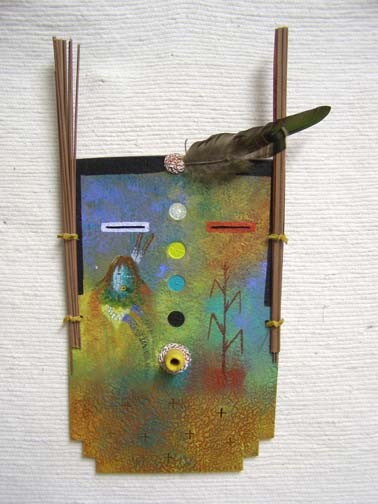
In Navajo history, masks represent the peoples’ interest in nature and spiritualism. With masks, tribe members are able to reveal their feelings and emotions toward particular things. When making them, Navajo people had the chance to demonstrate their creativity utilizing materials they could easily acquire, like wood, leather, feathers, and cloth.
Using Navajo Masks
Navajo artifacts like masks were worn during battle, shaman and initiation ceremonies, and religious rituals. Often, Navajo people wore them during ceremonies that involved dancing and singing. They used them to enhance the stories that they were telling through the dances and songs performed. The masks symbolized the transformation that a person made into the spirit world, and it let the personator identify with natural forces that were attempting to control him. In fact, Native Americans held the belief that the spirit that the mask represented took over the mask wearer’s body.
In the tribes, it was generally a high-status male (with plenty of creative skills) who worked in isolation and made the masks. Trained dancers were typically those who wore the masks. Women and children were permitted to watch the ceremony as a form of entertainment, but they were not allowed to know what the masks meant or the purpose of the story. If a mask was being used during a ritual, it would not be uncommon for only limited tribe members to understand the ceremony.
Many of the masks on display in museums and exhibits today are considered traditional. However, it’s important to note that culture and tradition are two different things. The masks that are included in Navajo tradition are a replication of a person’s wellbeing and entire persona. Different masks are customized to the individuals who make them. Along with this, ceremonial masks that include a picture are an imitation of the event or character that the wearer is depicting using song and dance.
Masks were also created to look like animals, and this speaks to the idea that the Navajo clans descended from different animals. The people often used their descendant line to create their masks. The masks also displayed the status of the person it was designed to look like.
Other Purposes
Navajo people gave masks as gifts and used them for decorative purposes. Some people created masks as portraits that portrayed someone important in the Native American culture. The detail of these masks was extensive. Some of them even included a labret (a lower lip piercing), in addition to neck furs and hats. Navajo masks included things like spruce branches and paint.
Masks were designed to depict gods like the mischievous rain god known as Tonenili; Haschebaad, a generous female god; and the god of harvests, Ganaskidi.
Different Types of Masks
Among Native Americans there are different types of masks. The first one is a single face mask. Fairly simple, a single face mask represents one persona. Native Americans also made mechanical masks that feature moving parts. For instance, a mechanical mask may have eyes or a mouth that can open or close. The last type of mask is referred to as a transformational one, which is basically two masks in one. The exterior mask would open to expose a second mask beneath it. In some cases, a second or even a third mask opened up to reveal additional masks.
Colors also expressed certain things about the masks. If a mask was red, it stood for faith or happiness. Orange and yellow depicted intelligence, and green meant nature, healing and harmony. A purple mask represented magic and mystery while black stood for success and victory. Blue illustrated intuition and wisdom, and white portrayed purity and light.
Navajo History is Intriguing and Unique
Navajo artifacts like masks are beautiful, intricate and full of meaning. The masks have always been more than just décor. They were created to share a greater purpose, one often involving the spirit world, and an attempt to understand the unknown.

